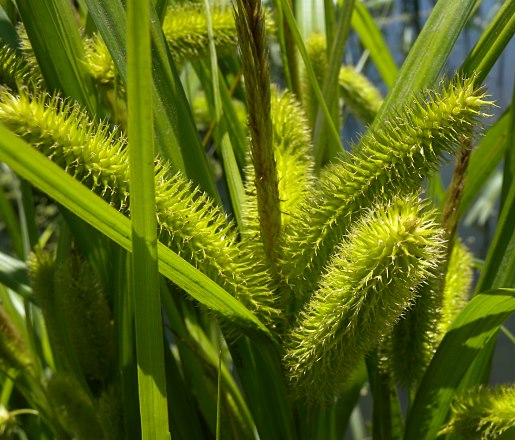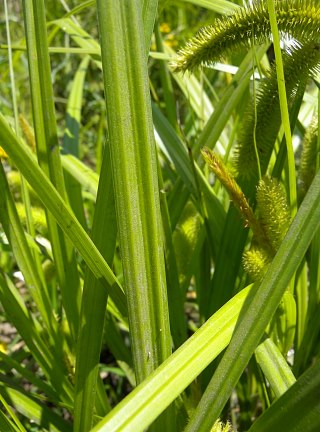Description: This perennial sedge forms a large tuft of leaves and flowering culms about 2–3½' tall. The erect to ascending culms are light green, sharply 3-angled, and glabrous. Alternate leaves occur along the entire length of the culm to the inflorescence. The widely spreading to ascending leaf blades are about 8-18" long and 6-17 mm. across; they are light to medium green and glabrous. The center of each blade is usually furrowed along its length. The sheaths are a little loose to firm; the outer 2 sides of each sheath are light green, veined, and glabrous, while the inner side is membranous. The ligules are longer than they are across; each short-membranous ligule has an upside-down V-shape.

Each fertile culm
terminates in an inflorescence consisting of 2-6 pistillate spikelets,
a terminal staminate spikelet, and their leafy bracts. The lowest bract
is up to 16" long and 12 mm. across, while the upper bracts are smaller
in size. Each pistillate spikelet is about 5-6 cm. long, 1.5 cm.
across, and cylindrical in shape; it has a bristly appearance from the
beaks and long teeth of the densely packed perigynia (bladder-like
sacs). These perigynia are widely spreading. Each perigynium is about
5-7 mm. long, 1.5 mm. across, lanceoloid in shape, longitudinally
veined, and glabrous; its bottom is wedge-shaped, while its beak has
two spreading teeth (1.0–2.0 mm. long). The pistillate scales are
usually a little shorter than the perigynia; they are lanceolate,
membranous with central green veins, and awned. At the base of each
pistillate spikelet, there is a slender stalk up to 1" long; the
pistillate spikelet is held erect or it may nod slightly from its
stalk. The terminal staminate spikelet is up to 7.5 cm. (3") long, very
narrow, and brown; it has a short stiff stalk at its base up to 1 cm.
long. The blooming period occurs from late spring to early summer.
Mature achenes are 1.5–2.0 mm. and a little less across; they are
ovoid-ellipsoid, bluntly 3-angled or a little flattened, and light
brown. The root system is fibrous and short-rhizomatous.
 Cultivation:
Bottlebrush Sedge prefers full sun to light shade, wet conditions, and
mucky or slightly sandy soil. It is one of the more ornamental sedges
that can used in rain gardens.
Cultivation:
Bottlebrush Sedge prefers full sun to light shade, wet conditions, and
mucky or slightly sandy soil. It is one of the more ornamental sedges
that can used in rain gardens.
Range & Habitat:
The native Bottlebrush Sedge is occasional in NE Illinois, uncommon in
central
Illinois, and rare elsewhere (see Distribution
Map). Habitats include swamps, bogs, seeps, margins of ponds
and oxbow lakes, marshes, swales in damp meadows, and ditches. This
sedge is often found in shallow water.
Faunal Associations:
Many insects feed on wetland sedges (Carex spp.).
This includes Stethophyma
celata (Otte's Sedge Grasshopper), Stethophyma
gracile (Graceful Sedge Grasshopper), Stethophyma
lineata (Striped Sedge Grasshopper), and Orchelimum volantum (Nimble Meadow Katydid). The caterpillars of the
butterfly Satyrodes eurydice (Eyed Brown) and
several skippers feed on the foliage. Other insects that feed on these sedges are the caterpillars of Hypocoenia inquinata (Tufted Sedge Moth) and Amphipoea americana (American Ear Moth), several leaf beetles (Plateumaris spp. &
others), the billbug Sphenophorus costipennis, the seedbugs Oedancala dorsalis
and Cymus angustatus, the stinkbug Euschistus ictericus, several leafhoppers
(Cosmotettix spp. & others), and many aphids (see Aphid Table).
Among vertebrate animals, many wetland birds eat the seeds or
seedheads. These include the American Coot, Wilson Snipe, several
rails, many ducks, and the Swamp Sparrow. The Sedge Wren constructs its
nest and hunts for insects in wetlands that are dominated by sedges.
Photographic Location:
Border of a marshy pond at Weaver Park in Urbana, Illinois.
Comments:
Bottlebrush Sedge is a member of a small group of wetland sedges that
have bottlebrush-shaped pistillate spikelets. They are attractive in
appearance, but require moist to wet conditions. Bottlebrush Sedge can
be readily distinguished from similar sedges by the long spreading
teeth of its perigynia (1.0–2.0 mm.); similar sedges have shorter teeth
that remain appressed together. It also has perigynia that are less
inflated than those of similar sedges. Another common name of Carex
comosa is Bristly Sedge.